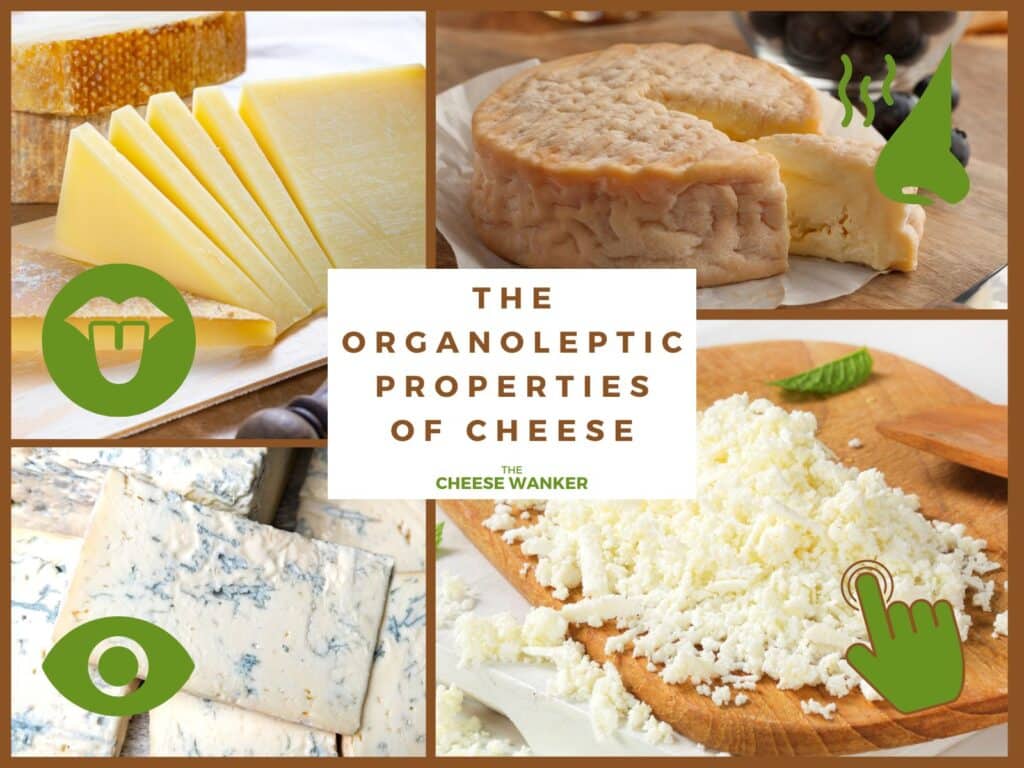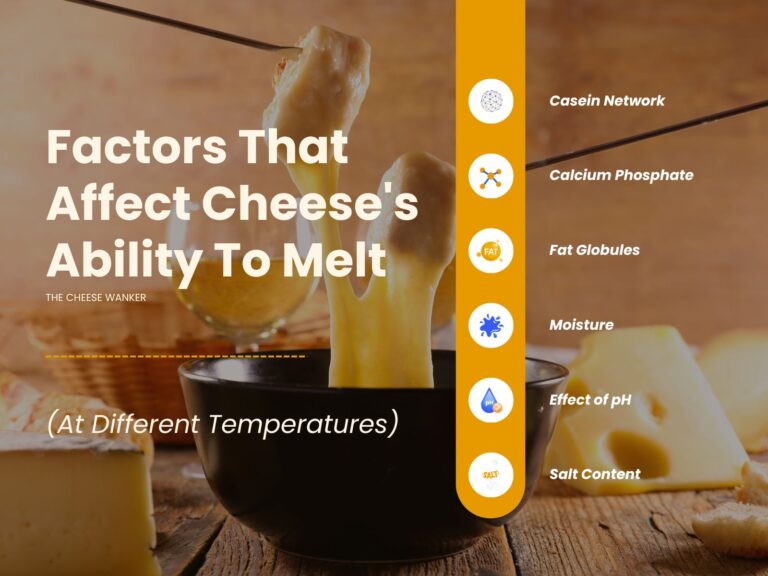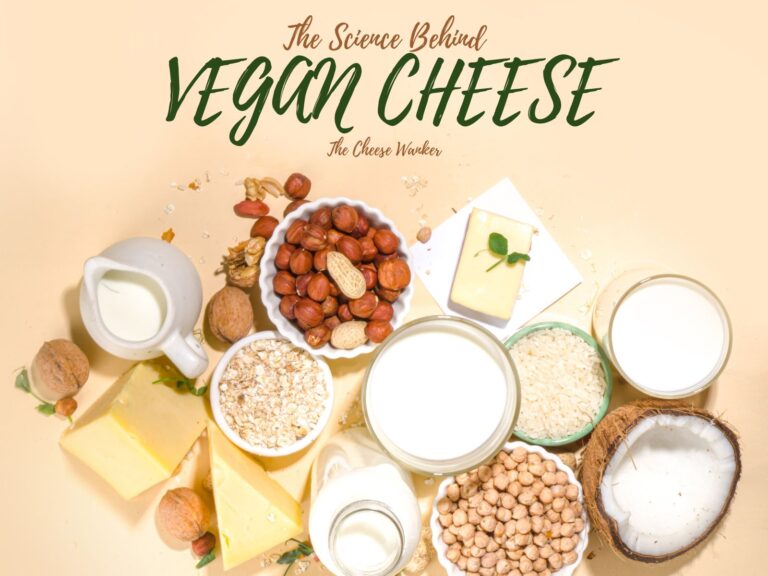Cheese is a beloved food item that has been enjoyed by humans for thousands of years. From tangy Cheddar to earthy Brie, cheese has a range of flavours that appeal to a variety of palates. Read on to learn more about the flavour and other organoleptic properties of cheese.

SEE ALSO: Our complete guide to assembling the perfect cheese board →
What are organoleptic properties?
Organoleptic properties are the sensory characteristics of a food or beverage that are perceived by the human senses. In fact, those include taste, smell, texture and appearance. Moreover, these properties can be subjective or objective, depending on the individual and the circumstances.
For example, some people may find a particular cheese to be too strong or pungent. While others may enjoy the same cheese for its complex and robust flavour.
What are the most common organoleptic properties present in cheese?
There are several organoleptic properties that are commonly associated with cheese, including taste, aroma, texture and appearance. Using popular cheeses as examples, we can explore these properties in more detail.
What cheese tastes like
Without a doubt, cheese is a nuanced food with a wide range of flavours. Actually, there are many factors that influence the flavour of a particular cheese. Those include the type of milk used, the processing method and the ageing process.
Some common flavours found in cheese include savoury, tangy, nutty, creamy, earthy, pungent, sweet and smoky. Also, different types of cheeses have their own unique flavour profiles. Some examples are the tanginess of Cheddar, the nuttiness of Gruyère and the earthy notes of Brie.
What cheese smells like
Moreover, the aroma of cheese can also vary widely depending on the type of cheese and its extent of ageing. Some common aromas in cheese include earthy, nutty, grassy, floral, fruity, woody and musky.
Blue cheeses such as Roquefort or Gorgonzola have a pungent, mouldy aroma, while washed rind cheeses like Taleggio or Epoisses have a strong yeasty and sometimes funky aroma. Furthermore, aged cheeses like Parmesan or Gouda may have a sweet or nutty smell. And, finally, fresh cheeses like Ricotta or Feta tend to have a light, milky aroma.
What cheese feels like
In addition to taste and smell, the texture of cheese also varies widely. Some common textures found in cheese include:
Soft: This includes cheeses like Brie or Camembert, which have a soft, creamy texture that becomes runny as they age.
Semi-soft: Cheeses like Havarti or Fontina have a slightly firmer texture, with a smooth and creamy consistency.
Semi-hard: Cheeses like Gruyère or Comté have a firm, dense texture that can range from slightly rubbery to smooth and sliceable.
Hard: Parmesan or Pecorino Romano are examples of hard cheeses, which have a crumbly, granular texture. As a result, they tend to make excellent grating cheeses.
Crumbly: Cheeses like Feta or Stilton have a crumbly texture that is easy to crumble or sprinkle.
Stringy: Finally, pasta filata cheeses like Mozzarella or Provolone have a stringy, elastic texture that makes them ideal for melting.
Overall, the texture of cheese can be influenced by factors such as the type of milk used, the processing method and the ageing process.
What cheese looks like
Finally, the appearance of cheese can vary depending on the milk used, the production methods and the maturation process. We can further break down this organoleptic property as follows:
Colour: A goat milk cheese like Brabander Gouda has a pristine white paste compared to a similar Gouda made with cow’s milk. The latter will develop a yellow to orange paste depending on age. Furthermore, the use of natural dyes such as annatto can impart a bright orange colour to both the rind and paste of a cheese.
Rind: Depending on the production and maturation methods, a cheese can either develop a natural rind, have an artificial rind, or have no rind at all. Some examples include the natural white bloomy rind on a Camembert or a red waxed rind on Edam. Also, some brined cheeses like Feta or Halloumi are completely rindless.
Veins: The addition of the mould Penicillium roqueforti to cheeses like Roquefort and Gorgonzola leads to the formation of blue veins within the cheese’s paste. You can read more about the spectacular phenomenon in our dedicated post here.
Eyes: Finally, you will have undoubtedly noticed that some cheese have holes in them. As a matter of fact, those holes are called eyes and are created by a very specific bacterium. Some examples of such cheeses include Emmentaler and Gouda. Learn more about this bacterium and how it works in our post covering this topic here.
Overall, the appearance of cheese is an important part of its organoleptic properties, as it can influence the consumer’s perception of its flavour and texture.
Summary: organoleptic properties matter
Cheese is a versatile and delicious food that has a range of organoleptic properties that contribute to its unique taste, aroma, texture and appearance. These properties can vary depending on the type of milk and the cheesemaking methods.
Moreover, the microorganisms and chemicals that create these properties are complex and can be affected by various factors, including ageing and temperature.
Whether you prefer a tangy Cheddar or a buttery Brie, understanding the organoleptic properties of cheese can help you appreciate and enjoy this beloved food even more. So next time you try a new cheese, take a moment to savour its unique taste, smell and texture.
What are your favourite organoleptic properties in cheese? Let me know in the comments below.



